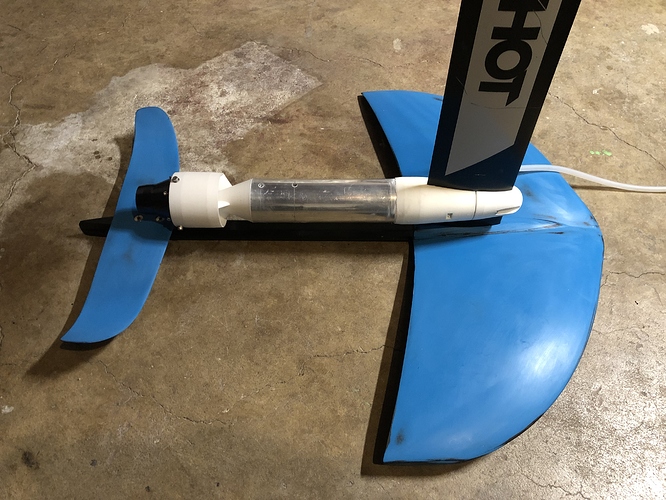Getting closer. Got the wiring through the mast done and assembled jet unit.
I tried measuring the thrust of my setup in an Ikea storage box. It maxed out at about 15kg before it went down quite a bit because of all the bubbles in the water — I need to measure it again in a bigger pool to give you a better answer.
At that time it was an SSS56104 500kv, 44V battery voltage. I recently switched to SSS56104 650kv. To be qualified.
Now you make me curious. What kind of advice would that be?
Probably similar advice to user WNT as I think they are the same user 
Won’t do…
I was thinking the same thing 
He will probably ask u to send him prop/imp so he can make it 60 times more efficient. U will also get a lesson on how to improve hydrodnamics without a single tip on your specific part. 
P.s. Wassap WNT, hows life? 
well if i can give an adivise: asked MHZ if it is the same impeller that is used with the jet drive-64, because it is hard to beleive that you can spin it to 25k rpm with a 56, when you need a hk-7455 and 16k rpm for the jetdrive (in that case it will make more sense to use a 56114 360KV may be with 12S)
more thrust: more rpm, it will be nice to know your rpm drop with 650kv (some esc can do that) , i had the same problem with my propeller setup and i increased kv without any succes, more rpm: big motor or more “smaller” propeller…
this is my experimental understanding since i don’t have any knowledge in hydro dynamics
Yeah, the problem is that lower kV with the same motor does not necessarily mean higher torque. And you need more torque for the higher rpm. The maximum rpm I saw with the original motor ( which was actually the 1000kV version, got that wrong) was about 8000 rpm
I see you went with the Slingshot mast, what gauge wires did you run up the mast, I’m dreading the effort it’s going to take to pass 3 wires plus a water line up the three channels.
I wanted a liquidForce mast but I ordered and already dinged my Slingshot mast - not good to return.
I’m using AWG8 wires. No chance getting them through the tiny outer channels. I ended up using the bigger central channel for the water cooling hose and the two smaller ones next to the center one plus one of the threaded holes for the wires. Which means I have only a single screw to hold the mast in the base. So I glued them together…
Interesting so you tested 1000kv and got
8000rpm with 6s?
Running the motor with 8v only…no?
No, I tested 1000kV with 6s, later with 12s, in water. Without submerging, aka no load, the motor easily reached 20,000rpm which I set as limit in the Motor controller. In water, the max rpm before sucking in a lot of air was about 8,000. At that point I had seen 15kg of thrust. Let me rerun and verify my measurements for the 650kV. At this point I don’t trust my own numbers as 8,000 actually seems low for 15kg, given that MHz says you should reach 15,000rpm for sufficient thrust.
My esc stores telemetry data: current, voltage, temperature, rpm: http://www.mgm-controllers.com/race-boats/speed-controllers-escs-1/tmm-25063-3-for-race-boats-x2-series.html
What did you use for gluing the mast to the plate?
